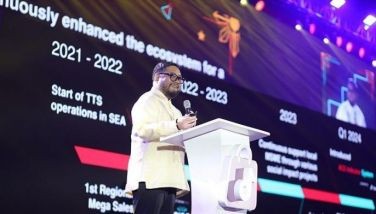Sing a song & build a nation

January 16, 2002 | 12:00am
 Kung ating susuriin at masusing titingnan
Kung ating susuriin at masusing titingnan
Maraming problema ng bayan, nagkaroon ng kalutasan
Maraming hinaing, nabigyan-katugunan
Dahil may nagkusang makialam
Sa pag-unlad ng bayan
Kasali ka, sumali ka
Tayo’y may kakayahang tumulong sa bansa
Kasali ka, sumali ka
Kung di ka kikilos, sino pa ba?
These lyrics were lifted from the song Kasali Ka, Sumali Ka, written by seasoned lyricist Marilyn Villapando, set to music by award-winning composer Mike Villegas, sung by Cris Villonco, and produced into a music video by Electromedia under the direction of Mark Gary. The collaborative effort was part of an integrated advocacy communication program in support of the recently held Social Development Week hosted by the Caucus for Development, the biggest coalition of non-government organizations in the Philippines. Its goals were to promote volunteerism, a stronger sense of responsibility among the youth, and encourage them to pursue a more active role in nation building.
A very important concern addressed by the music video was the apathy of some of today’s youth to country affairs. The lyrics were made very clear and simple, meaningful yet not too heavy as to turn off young people. The melody was light and upbeat, catchy and easy to sing along with, proving that the call for civic duty and national concern can be associated with fun and enjoyment. The song was pitched for airing pro bono in high-rating AM and FM radio stations, MYX Studio 23, and MTV. After substantial airplay, Kasali Ka, Sumali Ka became an instant hit, not only among its targeted public, but with the NGO community as well. In fact, it is now being considered for use in future youth-oriented projects, one of which is the forthcoming Sanggunian ng Kabataan election.
The power of popular entertainment in shaping the attitudes and behavior of a target audience is getting to be widely recognized by both public and private institutions in the Philippines, and in many parts of the world. The use of advocacy songs, TV sitcoms and variety shows, radio soap operas, movies, rock concerts, and street theater in espousing social causes, not only command the attention of their respective audiences, but more important, strengthen existing behavior, demonstrate a new one, and affect people’s emotions.
Government agencies pushing for social change enter into a partnership with movie and broadcast executives, print moguls, advertisers and ad agencies, the academe, non-profit organizations, and advocacy groups to collectively pursue programs that can educate people on how to help solve specific pressing issues affecting the country. Topics like domestic violence, drug addiction, family planning, environment protection, AIDS, and teenage pregnancy, among others, are presented to the market in entertainment formats without trivializing them. Knowing that a large percentage of Filipinos get educated about the issues through mass media, popular entertainment fares serve as potent vehicles for sharing information and moving people to positive action.
Such practice is called "Enter-Educate," a term coined by the Johns Hopkins University (JHU) Center for Communication Programs. It is a contraction of the words "entertainment" and "education." JHU describes it as any communication presentation that projects a pro-social educational message in an entertainment format. Every Enter-Educate program has two equally important components–the format (entertainment) and the message (education). The role of entertainment is to hold the audience’s attention by engaging their emotions, while education is to enhance the knowledge and skills of the learners so that they can reach their potential. Entertainment is fun. Education is empowering.
The idea of combining education and entertainment is not entirely new. Examples can be found in history. As JHU reported, myths have served important functions in societies around the world. Parables have been used by prophets to illustrate religious tenets. Fables have been used to demonstrate the validity of moral teachings. Aristotle, in his book Rhetoric, proposed some principles of persuasive communication that continue to hold true today. Referring to the orators of his day, he said, "Speakers should be credible, excite the emotions of the audience, and provide proof to support their arguments." Through the years, effective Enter-Educate has adhered to these principles.
The Enter-Educate approach started world-wide in 1989. The Philippines was one of the very first countries to test its power. I Still Believe, Lea Salonga’s duet with Charlie Masso of Menudo (yes, the Puerto Rican song-and-dance group where Ricky Martin started) singing about the joys and pains of being young, and the ensuing TV spots encouraging troubled teenagers to use the Dial-A-Friend hotline to discuss their problems, opened the local Enter-Educate floodgates.
Multi-awarded Anak ng Pasig – written by Yoly Ong and Villapando, composed by Jimmy Antiporda, and popularized by Geneva Cruz – which mused on the deplorable state of what was once upon a time a clean, beautiful and romantic Pasig River, quickly followed. It proved that a song with a socially relevant message can also be a commercial success. Cruz’s rendition became a popular hit, garnering for her a platinum album. It was also recognized by award-giving bodies like the Catholic Mass Media, and the Philippine Association of the Recording Industry. Since then, many other programs rode the trend, and used it to great advantage.
Indeed, Enter-Educate has become an important agent for social change and development, since researchers have been able to measure its effectiveness and efficiency. Phylis Piotrow, JHU/CCP director, observed, "We have learned that if you can produce an entertaining soap opera, viewers will remember and identify with characters making important decisions, and the consequences of those decisions."
The Enter-Educate approach has proven its usefulness as a communication tool. Its popularity and pervasiveness allow it to reach everyone, everywhere via media, events, music or drama. The passion that emotional performances bring can make many Enter-Educate messages reverberate at a personal level, and often draw out passionate participation from the target audience. JHU projects that as Enter-Educate programs become more profitable and more capable of influencing people’s attitudes, intentions, and behavior, practitioners and would-be practitioners will increasingly pay attention to how they develop the best products and performances.
In the Enter-Educate process, if you are not moved by what you do, other people will not be moved either.
BrandSpace Articles
<
>



















